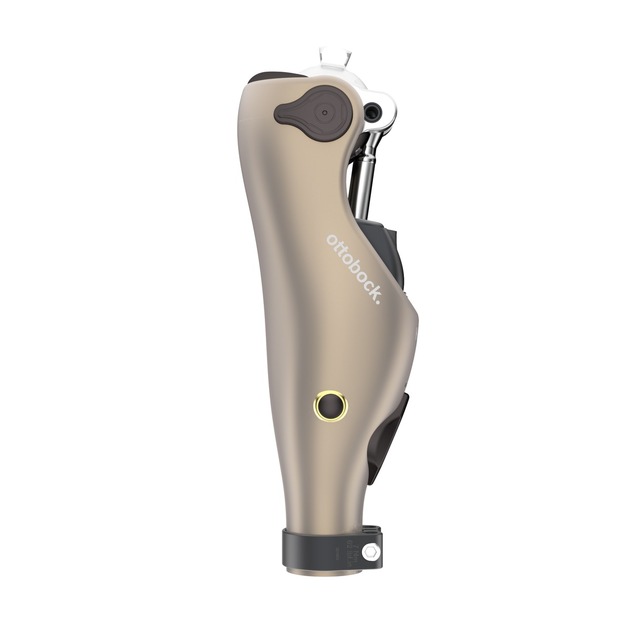High-tech prosthesis for enhanced safety: New Kenevo knee joint available
High-tech prosthesis for enhanced safety: New Kenevo knee joint available
With exercise bike function, support for walking down ramps and an app
About six years after its initial launch, the new version of the Kenevo microprocessor-controlled prosthetic knee joint is now being released to the market. It incorporates the accumulated experience of users, O&P professionals and physiotherapists in 40 countries. The Kenevo is the first high-tech knee joint tailored especially to the largest user group: Users with a low mobility level who mainly move about at home, and newly amputated people who are learning how to use their prosthesis. The result: More support while walking down ramps, greater freedom of movement for getting dressed, convenient charging with a cosmetic cover and an app for configurations. The goal is to make users feel safer and thus increase their independence.
Users report that they are able to move about more easily on uneven surfaces, with fewer falls. Clinical studies show that to this effect, the Kenevo has advantages over mechanical prostheses: 50% of users never stumbled, and 72% never fell.* Orthopaedic technician Rainer Neddermeier reports similar successes from the John + Bamberg medical supply store: "We fitted an elderly lady with a Kenevo. She had been hit by a car and required an amputation. Her stability kept improving and she did not suffer any falls during the entire time."
Functions of the next-generation Kenevo
The new Kenevo produced in Vienna offers new functions. They include a mode for training with an exercise bike, which supports rehabilitation. The joint adjusts automatically when the user gets on the exercise bike. "A test user sat on an exercise bike for the first time during the development of the new Kenevo. He liked it so much that he now trains regularly on it at home," reports Chief Technology Officer (CTO) Dr Andreas Goppelt. Another new feature is the additional support provided when walking down ramps.
As in the past, therapists adjust the preconfigured modes to match the user's individual activity. A higher activity mode is appropriate when users become more mobile through rehabilitation. When they need more stability, the mobility of the knee joint can be restricted. The joint is locked in the lowest activity mode A and does not initiate a swing phase, allowing the user to get accustomed to the prosthesis over short distances. In the middle activity mode B, the Kenevo allows users with low mobility to reliably trigger the swing phase. Mode B+ permits stance phase flexion up to 10 degrees, even for users with low residual limb strength, and walking on slight inclines. In the highest activity mode C, the stance phase is no longer locked, and users can walk down stairs and steeper ramps alternatingly. Intuitive basic functions such as supported sitting down complement these activity modes. Stumble Recovery Plus offers added safety regardless of the selected activity mode.
Digital support in rehabilitation and daily life
As is the case with all mechatronic knee joints from Ottobock, the new Kenevo can be adjusted using an app. Users do not have to be tech savvy. The digital solution improves their comfort and safety. Competent professionals continue to look after everything else: Without the need for additional support by technicians, certified physiotherapists can change activity modes with the Kenevo A-B-C app and adapt them to therapy. Physiotherapist Henning Lauterbach says: "I am very happy to have the app. It makes adjusting the activity modes much easier." Aside from the A-B-C app, the new Kenevo can also be connected to the Cockpit app: With this program, which is already familiar from other prostheses such as the C-Leg, users can independently activate and deactivate certain settings such as the intuitive exercise bike mode. This makes the prosthesis customisable. Information such as the knee joint's charge level, the number of steps taken and the next service date can also be read via a smartphone.
Another new feature is easy charging of the prosthesis using a cosmetic foam cover. The cosmetic cover is worn by many users to visually adapt the prostheses to the leg. Now the charging cable can be connected even with the cosmetic cover in place. It also makes it easier to put on the prosthesis while in a sitting position by bending it in after removing the charging plug. The Kenevo is now approved for the hip disarticulation amputation level as well.
* Effects of a Novel Microprocessor-Controlled Knee Kenevo on the Safety, Mobility, and Satisfaction of Lower-Activity Patients with Transfemoral Amputation, Mileusnic MP, Hahn A, Reiter S, J Prosthet Orthot, 2017, 29(4), 198-205 [ link]
Information: Additional studies, events and user interviews are coming in August.
Maja Hoock
Public Relations Managerin
Ottobock SE & Co. KGaA, Prenzlauer Allee 242, 10405 Berlin
Handy: +49 151 18883507
E-Mail: maja.hoock@ottobock.de
About Ottobock: Ottobock develops “wearable human bionics” – medical technology products for people with limited mobility in the fields of Prosthetics, Orthotics and Human Mobility (wheelchairs). The company founded in Berlin in 1919 also treats patients in its Patient Care division. Its mission: Enhancing quality of life and health economic benefits. Subsidiaries in around 60 countries offer “Made in Germany” quality worldwide and employ more than 8,000 people. Ottobock has been supporting the Paralympics with technical expertise since 1988.


